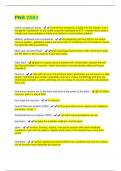Exam (elaborations)
PNB 2XB3 QUESTIONS & ANSWERS GRADED A+
- Course
- Institution
sodium potassium pump - ️️enzyme that transports 3 sodium to the outside, and it transports 2 potassium to the inside using the hydrolysis of ATP - creates more sodium outside and more potassium inside and creates a concentration gradient Midline, ipsilateral and contrelateral - ️️line s...
[Show more]



